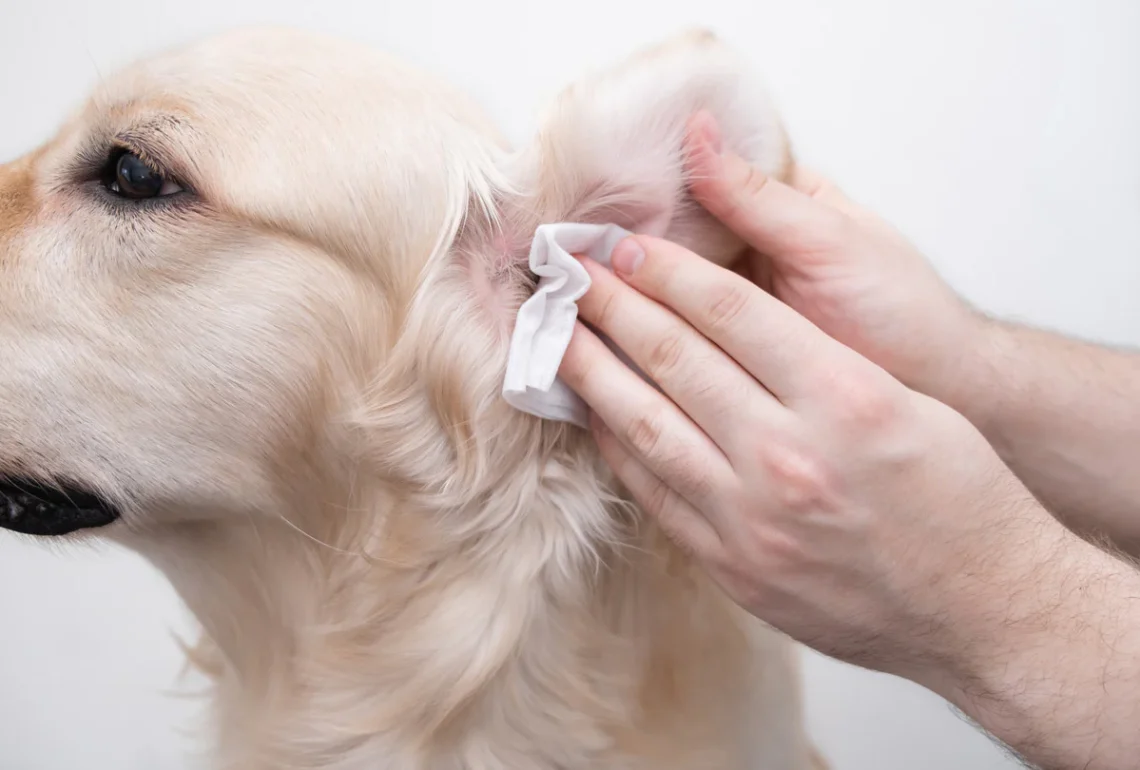Regular ear cleaning is an essential part of responsible pet ownership, yet it’s often overlooked until problems arise. For dogs, ear health is particularly important because their ear canals are structured differently than humans’, making them more susceptible to wax buildup, moisture retention, and subsequent infections. While commercial ear cleaning solutions are readily available, many contain harsh chemicals that can irritate sensitive ears or disrupt the natural balance of beneficial microorganisms.
Natural ear cleaning solutions offer a gentler alternative that can effectively remove excess wax and debris while maintaining the ear’s natural protective mechanisms. When properly administered, these homemade solutions can keep your dog’s ears clean, healthy, and comfortable without exposing them to potentially irritating synthetic ingredients. However, it’s crucial to approach ear care with knowledge and caution, as improper cleaning techniques can do more harm than good.
Understanding Canine Ear Anatomy and Health
To clean your dog’s ears effectively and safely, it helps to understand their unique structure:
The L-Shaped Ear Canal
- Vertical Canal: Extends downward from the ear opening
- Horizontal Canal: Extends inward toward the eardrum, creating an L-shape
- Unique Challenges: This structure makes complete cleaning difficult and allows moisture to accumulate
Normal Ear Function
- Natural Cleaning: Healthy ears have a self-cleaning mechanism that moves debris outward
- Wax Production: Earwax (cerumen) protects the ear canal and traps debris
- Beneficial Bacteria: A natural microbial balance helps prevent harmful infections
DIY Natural Cleaning Solution
A simple, effective cleaning solution can be made with common household ingredients:
Gentle Ear Cleaning Solution
- 1/2 cup distilled water (or boiled tap water that has cooled completely)
- 1/4 cup witch hazel (alcohol-free)
- 1 tablespoon apple cider vinegar (raw, unfiltered)
- Mix Ingredients: Combine all ingredients in a clean bottle or container with a tight-fitting lid.
- Shake Well: Mix thoroughly before each use to ensure ingredients are well combined.
- Test Temperature: Ensure the solution is at room temperature before application.
- Storage: Store in a cool, dark place for up to 2 weeks. Shake before each use.
Alternative Solution for Sensitive Ears
- 1/2 cup distilled water
- 1/4 cup witch hazel (alcohol-free)
- Omit apple cider vinegar for extremely sensitive ears
The Cleaning Technique
Proper technique is essential for effective and safe ear cleaning:
- Prepare Your Space: Choose a comfortable, well-lit area where your dog feels relaxed. Have all supplies ready before beginning.
- Examine the Ears: Gently lift the ear flap and visually inspect the outer ear canal. Look for redness, swelling, discharge, or unusual odors.
- Apply Solution: Squeeze enough cleaning solution into the ear canal to fill the vertical portion (about 1-2 mL for small dogs, up to 5 mL for large dogs).
- Massage Base: Gently massage the base of the ear for 10-15 seconds to help loosen wax and debris. You should hear a squishing sound.
- Allow Shaking: Let your dog shake its head to bring loosened debris to the outer ear.
- Wipe Away Debris: Use cotton balls or gauze pads to gently wipe away debris from the visible parts of the outer ear. Work from the inside out.
- Repeat if Necessary: For very dirty ears, you may repeat the process once more.
- Reward Your Dog: Praise and treat your dog to create a positive association with ear cleaning.
- Never insert cotton swabs, fingers, or any objects into the ear canal
- Stop immediately if your dog shows signs of pain or distress
- Do not clean ears more than once a week unless directed by a veterinarian
- Avoid getting water or cleaning solution in the middle ear if the eardrum is ruptured
What NOT to Do
Avoiding common mistakes is as important as following proper techniques:
Dangerous Practices
- Cotton Swabs: Can push debris deeper and potentially damage the eardrum
- Excessive Cleaning: Can remove protective wax and disrupt natural ear balance
- Harsh Chemicals: Alcohol, hydrogen peroxide, or strong detergents can irritate sensitive ears
- Deep Insertion: Anything inserted deep into the ear canal poses injury risks
Inappropriate Solutions
- Undiluted Vinegar: Too acidic for regular use and can cause irritation
- Human Ear Drops: Formulated for different ear anatomy and may contain harmful ingredients
- Essential Oils: Many are toxic to dogs and can cause serious reactions
- Tap Water: May contain minerals or chemicals that can irritate sensitive ears
Signs That Require Veterinary Attention
While routine cleaning can be done at home, certain symptoms indicate the need for professional care:
- Foul or strong odor emanating from the ears
- Redness, swelling, or discharge from the ear canal
- Head tilting or loss of balance
- Excessive scratching, head shaking, or signs of pain
- Hearing loss or unusual responsiveness to sounds
Conditions to Monitor
- Recurring Infections: May indicate underlying allergies or anatomical issues
- Persistent Debris: Excessive wax production may require medical evaluation
- Breeding Predisposition: Dogs with floppy ears or history of ear issues need closer monitoring
- Seasonal Changes: Some dogs experience more ear issues during certain times of year
Breed-Specific Considerations
Different breeds have varying ear care needs:
High-Maintenance Breeds
- Floppy-Eared Breeds: Cocker Spaniels, Basset Hounds, and Beagles need more frequent cleaning due to reduced air circulation
- Water-Loving Dogs: Retrievers and water dogs require extra attention after swimming or bathing
- Hairy-Eared Breeds: Poodles and Schnauzers may need hair plucking around the ear canal for proper air flow
Low-Maintenance Breeds
- Upright-Eared Breeds: German Shepherds and Australian Shepherds generally have better air circulation
- Short-Haired Breeds: May require less frequent cleaning due to reduced debris accumulation
Frequency and Timing
Proper cleaning schedule prevents both under- and over-cleaning:
General Guidelines
- Normal Ears: Clean once every 1-2 weeks as part of routine care
- Problem Prone Ears: May require weekly cleaning or as directed by a veterinarian
- After Water Exposure: Clean ears after swimming, bathing, or heavy rain exposure
- Seasonal Adjustments: Increase frequency during high humidity or allergy seasons
Best Times for Cleaning
- Post-Exercise: When your dog is already calm and relaxed
- Before Bedtime: Allows time for any residual solution to dry
- Consistent Schedule: Regular timing helps dogs anticipate and accept the routine
Additional Natural Approaches
Beyond cleaning solutions, several natural methods can support ear health:
Dietary Support
- Omega-3 Fatty Acids: Support overall skin and coat health, including ear canal lining
- Probiotics: May help maintain healthy microbial balance throughout the body
- Hydration: Proper water intake supports healthy mucous membranes
Environmental Management
- Humidity Control: Use dehumidifiers in damp climates to reduce moisture in ears
- Allergen Reduction: Minimize exposure to environmental allergens that can contribute to ear issues
- Regular Grooming: Keep hair around ear canals trimmed for better air circulation
Making Ear Cleaning a Positive Experience
Creating positive associations reduces stress for both you and your pet:
Training Techniques
- Start Early: Begin ear handling with puppies to establish comfort
- Gradual Introduction: Touch ears during regular petting before attempting cleaning
- Positive Reinforcement: Use treats, praise, and calm tones throughout the process
- Short Sessions: Keep initial cleaning sessions brief and gradually increase duration
Comfort Measures
- Calm Environment: Choose quiet, familiar spaces for cleaning
- Gentle Touch: Use soft, deliberate movements rather than quick actions
- Consistent Routine: Follow the same steps in the same order each time
- Timing: Clean when your dog is relaxed, not immediately after exercise or play
Storage and Safety
Proper storage and handling ensure solution effectiveness and safety:
Storage Guidelines
- Cool, Dark Place: Store solutions away from heat and direct sunlight
- Proper Containers: Use clean, sterilized bottles with tight-fitting lids
- Labeling: Clearly mark contents and preparation date
- Shelf Life: Discard homemade solutions after 2 weeks to prevent bacterial growth
Safety Precautions
- Individual Ingredients: Check that all components are fresh and within expiration dates
- Allergy Testing: Test small amounts on your dog’s skin before ear application
- Cross-Contamination: Use separate applicators for each ear to prevent spreading infections
- Hygiene: Wash hands thoroughly before and after cleaning procedures
Troubleshooting Common Issues
Addressing problems that may arise during ear cleaning:
Cleaning Challenges
- Uncooperative Dogs: Enlist help from family members or consider professional grooming for difficult cases
- Excessive Debris: Very dirty ears may require multiple cleaning sessions spaced over several days
- Solution Rejection: Try different temperature or reduce the amount of vinegar in the solution
- Incomplete Cleaning: Focus on visible areas and don’t attempt to clean deep into the canal
Treatment Adjustments
- Irritated Ears: Reduce cleaning frequency and consider gentler solutions
- Persistent Odor: May indicate infection requiring veterinary attention
- Excessive Wax: Could signal underlying health issues needing professional evaluation
When to Consult a Professional
Recognizing when home care isn’t sufficient:
- Visible signs of infection (pus, blood, severe redness)
- Persistent head shaking or ear scratching despite cleaning
- Suspected foreign objects in the ear canal
- History of ear surgery or perforated eardrums
Veterinary Cleaning Benefits
- Specialized tools for safe, thorough cleaning
- Microscopic examination for underlying conditions
- Prescription medications when infections are present
- Professional guidance on home care techniques
Long-Term Ear Health Management
Sustainable practices for ongoing ear wellness:
Preventive Measures
- Regular Inspection: Weekly visual checks for early problem detection
- Environmental Modifications: Reducing allergens and moisture exposure
- Nutritional Support: Maintaining a diet that supports skin and coat health
- Breed-Specific Care: Adapting routines to individual dog needs
Record Keeping
- Document cleaning dates and observations
- Note any reactions to specific solutions or techniques
- Track seasonal patterns in ear health
- Maintain communication with veterinary professionals
Conclusion: Gentle Care for Healthy Ears
Proper ear care is a fundamental aspect of responsible pet ownership that contributes significantly to your dog’s overall health and comfort. By understanding the unique anatomy of canine ears and following safe, natural cleaning practices, you can help prevent the discomfort and potential complications associated with ear problems.
The key to successful ear care lies in maintaining a gentle, consistent approach that respects the natural functions of your dog’s ears while addressing the specific needs of their breed and lifestyle. Natural cleaning solutions offer an effective alternative to commercial products, allowing you to provide care without exposing your pet to potentially harsh chemicals.
Remember that ear cleaning should never be a stressful experience for either you or your dog. Taking time to create positive associations through patient training and gentle handling will make routine care easier and more effective. Your investment in learning proper techniques and maintaining consistent care will pay dividends in your pet’s comfort and long-term ear health.
As you implement these natural ear care practices, you’re participating in a holistic approach to pet wellness that considers not just immediate needs but also long-term health and quality of life. Your attention to this often-overlooked aspect of care demonstrates the kind of thoughtful stewardship that strengthens the bond between humans and their canine companions.
Most importantly, maintain open communication with your veterinary professionals. They can provide guidance on the most appropriate care methods for your specific dog and help you recognize when natural approaches are sufficient or when professional intervention may be necessary. By combining the best of natural care with professional expertise, you can ensure your beloved companion enjoys healthy, comfortable ears throughout their life.





